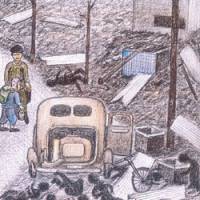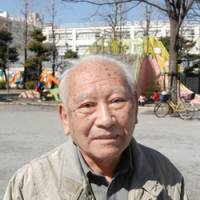Sixteenth in a series
The blasts were so bright that March 10, 1945, night that Hiroshi Kobayashi could see the pilots' faces in the low-flying formation of B-29 bombers as they dropped some 2,000 tons of incendiary shells and other explosives on his crowded Tokyo neighborhood.
"I could catch a glimpse of the people inside the cockpit. The sound of the planes was earsplitting," Kobayashi recalled. What became known as the Great Tokyo Air Raid involved some 300 U.S. B-29s and left over 100,000 Tokyoites dead in the conflagration.
Standing on a bustling intersection in Koto Ward, Kobayashi, 80, raises his right hand to shoulder height and slowly pans from left to right.
"The attack destroyed everything in sight in this area. Except for the corpses piled up on the streets, there was nothing. Absolutely nothing," he told The Japan Times in a recent interview.
As the 63rd anniversary of one of the most devastating air raids in history approaches, survivors of the Great Tokyo Air Raid to this day remain traumatized by the night's terror.
"It's hard to believe I survived that night, let alone lived to this age. The experience gave me a sense of mortality, and I've tried to live my life without regrets ever since," Kobayashi said.
Born and raised in the Shitamachi (literally downtown) district of Asakusa, Kobayashi, whose father owned a tatami shop, worked at a munitions factory while studying industrial technologies at night school during the war.
But by March 1945, even 18-year-old Kobayashi realized Japan was losing.
"We were asked to provide ammunition of poor quality to the army, although we knew they couldn't be fired straight. Japan was already backed into a corner" by the time of the air raid, he said.
The elderly Tokyoite remembers arriving home at around 9:30 p.m. on the night of the air raid. After eating some sweet potato, which had become the only food available for many families, he went to bed — only to be woken by his father screaming at him to run.
"An incendiary shell had hit two houses down. I was given a futon to cover myself and told to go."
The metallic scent of incendiary shells hung over the neighborhood as Kobayashi fled eastward.
He crossed the Sumida River, but the blaze on both sides of the Umaya Bridge was so strong that the fierce combustion sucked the oxygen from the overpass. Driven by the flames, the air current that was generated sucked up water from the river and dumped it on the terror-stricken masses.
Desperate to avoid the heat and the panic on the ground, many dived into the river, fully clothed, from the bridge.
"It was scorching and I wanted to jump in as well. But I saw that those who dived never surfaced," he recalled.
Kobayashi spent the night dodging the fire, seeking haven near the Kokugikan district in Ryogoku and around Honjo in eastern Tokyo. He saw neighbors, some severely burned, calling for help, but could not stop to aid them.
"I couldn't lend a hand, although people were on fire from the incendiaries. There was nothing I could do but run," he said.
The raid destroyed his house in Asakusa, but Kobayashi, his father and his older brother survived the night and met up at the rubble in the morning. They shared some sweet potato before walking north to a relative's house in Senju, Adachi Ward. Kobayashi kept his piece of potato to share it later with his mother, but she never returned.
For days, his father returned to the ruined Asakusa district to search for his wife's body.
"He turned over burned bodies, but we never found our mother," Kobayashi said.
Survival in the devastation was arduous, due to the lack of shelter, fuel and food. Families were forced to chop down wooden telephone poles to warm their homes. The air raids continued, including one that June that hit Kobayashi's munitions factory, wounding him in the left leg.
Yet despite the ordeal, Kobayashi skipped the opportunity to join a lawsuit against the government last March, when 112 citizens demanded ¥1.23 billion in reparations from the state for the damages they suffered.
"It's not that I am not annoyed by the government. I also think the U.S. is responsible for my mother's death . . . but I guess my loss must be endured because Japan lost the war," Kobayashi said.
Instead, Kobayashi has worked to spread a message of peace for the last 20 years, drawing over 30 sketches of the Great Tokyo Air Raid based on hastily scribbled notes he took on the night of the attack.
"Considering the amount of agony that a single bomb can cause, there is no such thing as a good war or a bad war. Even if it is justifiable, men should never engage in war," he said.
Following Japan's surrender, Kobayashi had an arranged marriage and began working for a construction company. He has two children and two grandchildren, and enjoys making cutout pictures at his home in Koto Ward.
Puffing on a cigarette, the former munitions worker said he was amazed he survived the night of the raid, the chaos following the war, the decades of Japan's reconstruction and his 60-year, pack-a-day John Player Special cigarette habit.
"I still remember my mother's face, although all the pictures were burned. She was such a kindhearted person," Kobayashi said.
"Although I never saw my mother after the night of the attack, it could be that she has been looking at me from heaven all these years."
In this occasional series, we interview firsthand witnesses of Japan's march to war and its crushing defeat, who wish to pass on their experiences to younger generations.






















With your current subscription plan you can comment on stories. However, before writing your first comment, please create a display name in the Profile section of your subscriber account page.